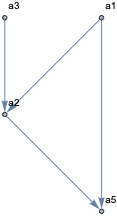Prepare some dummy data to investigate:
alist = RandomSample[Table[ToExpression["a" <> ToString[i]], {i, 1, 10000}]];
range = Range[10000];
Do[
len = RandomInteger[{3000, 10000}];
select = Sort[RandomSample[range, len]];
sublists[j] = alist[[select]];
, {j, 1, 5000}]
we have 5000 sublists of length between 3000 and 10000 elements "ai" in a particular order. I would like to have a function that merges all 5000 sublists such that all duplicates are discarded and any "ai" appear to the left of "aj" if they do so in any of the sublists. How can one do this in Mathematica most efficiently?
A tiny example of the above would be:
alist = {a1,a3,a2,a5,a4};
sublists[1] = {a1,a5};
sublists[2] = {a3,a2,a5};
sublists[3] = {a1,a2};
so that the function merge returns:
merge[Table[sublists[i],{i,1,3}]]
{a1,a3,a2,a5}
Note that merge was not given the actual alist.
EDIT:
Investigating the Experimental'ShortestSupersequence command, let us replace the definition of alist above by
alist = Table[a[i], {i, 1, 10000}];
This creates a list of strictly increasing a[i]. Generating the sublists from this as above, we get for example
seq = Fold[Experimental`ShortestSupersequence, sublists /@ Range[5000]];
seq//Length
10984
Repeating the steps seems to consistently return a seq that is longer than 10000, while
seq // DeleteDuplicates // Length
10000
To check that all sublists contain a[i] elements in strictly increasing order, we can do:
FreeQ[
Table[
tmp = sublists[i] /. a[x_] -> x;
tmp = tmp[[2 ;;]] - tmp[[;; -2]];
FreeQ[tmp/Abs[tmp], -1]
, {i, 1, 5000}]
, False]
True
The only way how some of the sublists might have some elements reversed in inconsistent order with alist is if we had {...,a[i],...,a[j],...} with j<i somewhere, which is ruled out by the above test. So it seems that Experimental'ShortestSupersequence is buggy...


alist) $\endgroup$Sortafter theRandomSampleof the integers inrange. This picks elements fromalistin an ordered way. $\endgroup${a3, a1, a2,a5}is also a solution, right? $\endgroup$alistthere are several solutions. Finding any of them should be good enough though. You are right, maybe I should describe the merging better. $\endgroup$